Good Vs. Bad Bugs: How Environment Affects Horses’ Gut Health

Anyone who has experience with horses is aware of the very real threat of losing a horse to colic or other gastrointestinal disease. But looking back on the history of equine death causes, colic still holds the same percentage as it did 20 years ago, standing firm as the second highest cause of death behind natural causes. Why hasn’t modern medicine decreased the chance of losing horses to colic? Why do we all still share the common fear of our horses colicking out of the blue, with little warning and minimal reliable strategies to prevent problems?
The answers to these questions remain a work-in-progress, but over the past 10 years, veterinarians and researchers have learned a lot about the role of the equine gut microbiome on all sorts of health outcomes, including colic, maldigestion, dysbiosis, and a myriad of other health problems.

The equine gut microbiome is an ecosystem composed of quadrillions of microbes, including bacteria, fungi, and even viruses, which interact and coexist in the gastrointestinal tract and contribute to overall gut health and well-being. In equines, when the microbiome is disrupted in such a way that populations of beneficial bacteria and yeast have declined and/or populations of harmful pathogenic bacteria and yeast have increased, it is not unusual to see issues such as colic and colitis, laminitis, among other serious conditions.
Like each individual horse, each microbiome is unique; regional, dietary, and even breed and genetic differences can create diverse microbiomes, and varying degrees of digestive health. Even within one horse’s microbiome, the “top end” of the colon can be drastically different from the “bottom end” in terms of the population and diversity of microbes. The way all the organisms perform and act within the microbiome determines the functionality of the gut as a whole. Board-certified internal medicine specialist Dr. Peter Heidmann leads the Internal Medicine department at Palm Beach Equine Clinic and takes us on a deeper dive into the equine gut microbiome.
Microbiome and Nutrition
“When we’re working to improve overall GI health, we are basically trying to increase the population of ‘good bugs’ and crowd out the ‘bad bugs,” Dr. Heidmann remarked. The combination of probiotics, prebiotics, and diet are all key factors that influence what happens on the inside of a horse’s gut. According to Dr. Heidmann, a well-balanced diet is most important, but the sources of nutrients also play a huge role in promoting gastrointestinal health.
“Probiotics can limit lactic acid production and prevent huge swings in pH in the cecum. This happens through many pathways, but largely by encouraging fiber fermenters over bacteria that like to gobble sugars and produce lactic acid,” he said. “Prebiotics provide additional, non-starch nutrients and are meant to support healthy flora, or microbes. Prebiotics also limit the likelihood and severity of dysbiosis, or microbial imbalance, when the diet changes, like what can happen following sudden exposure to too much starch-rich feed.”
Excessive amounts of starch-rich grains can reduce populations of healthy flora, decrease the types of bacteria that are present in the colon, and also promote overgrowth of unhealthy flora. In turn, overly homogenous populations limit a horse’s resilience to stress, dietary changes, and other unpredictable changes such as those in weather.

Oats and other starch-rich grains cause increases in propionic acid-producing bacteria, while hay-only diets increase acetic acid-producing flora, and therefore promote more diverse and stable populations of beneficial bacteria and yeasts. On the flipside, feeding hay and no grain means the nutrients are being digested much more slowly and will promote more diversity and stability of flora populations.
“At the same time, some ‘good’ bugs are also decreased when a hay-only diet is fed, especially ones that rely on easy-to-digest starchy grains,” noted Dr. Heidmann. “One type of organism, the Lachnospiraceae, is among the most prevalent type present in a healthy horse’s hindgut, and its population also diminishes when grain is not being fed.”
Ultimately, some easily digestible concentrate feeds promote healthy bacterial populations and release lots of energy quickly, yet it is fairly easy and risky to over-do the easily digestible feed. Not only do abrupt changes in diet increase the risk of upsetting a horse’s healthy microbiome, but feeds that are high in carbohydrates can also promote gas formation, lactic acidosis, and other types of colic. “Simply put, garbage in equals garbage out,” Dr. Heidmann explained.
Other Stressors to the Microbiome
Aside from what goes into the horse, there are other factors that determine the behavior of the microbiome and the overall functionality of the gut. Genetic makeup almost certainly plays a role in the way organisms manage the nutrients going in and, in turn, impacts the horse. Stress is another significant factor that definitely has a relationship with the gut, though it remains difficult to draw clear lines of “cause and effect” when studying all the ways that stress affects a horse’s gut health.


It is common knowledge among trainers that horses with anxious, “stressed-out” personalities seem prone to developing stomach ulcers. Separate from stress caused by riding, changes in surroundings, or even changing stablemates can make a difference in the organisms in a horse’s gut. Even when the feeding program remains consistent, a change in workload or their neighboring stall-mate invites stress and can promote ulcers.
“There is reason to believe that colon ulcers indicate problems in the gut microbiome,” said Dr. Heidmann. “Organisms, both healthy and not, vary between different barns, even in the same region or town, and those differences are also associated with differences in a horse’s microbiome. Even if horses are on the exact same food, with the same hay and turnout schedule, the flora is going to be different due to varying exposure to new microorganisms.” But this doesn’t mean we shouldn’t subject our horses to change. Many competition horses are accustomed to changes in environment and can perform without major gastrointestinal issues. The primary goal is to maintain as much consistency as possible when horses go through geographical changes that may disrupt their gut health.
“The relationship between stress and gut health isn’t as simple as a cause-and-effect relationship, where stress leads to a direct change in the behavior of the bugs, or where a change in flora directly increases a horse’s stress levels. It is a complex, dynamic interaction; it’s a constant feedback loop.”
Dr. Heidmann
It is difficult enough to separate cause from effect when looking at the relationships between gastrointestinal flora and factors like diet, exercise, pre- and probiotics, or supplemental digestive enzymes. But explaining the relationship between horse’s behavior and their GI flora is inherently subjective, and therefore even more difficult to confirm.
“It may seem far-fetched to think that a horse’s behavior might be affected by the balance of flora in their GI tract, but some microbes appear to have developed mechanisms that encourage certain behaviors by producing compounds that mimic the horse’s own neurotransmitters,” reflected Dr. Heidmann. “This can translate into increasing hunger signals or stimulating cravings for certain foods. Some microbes can enhance taste sensation, and others can co-opt a horse’s normal signaling pathways to enhance mood or increase discomfort by slowing gastrointestinal motility. Any or all of these mechanisms may be up or down regulated during changes in the balance of GI flora.”
Still More to Learn
Veterinary science and research still have a long way to go to draw firm associations between illness and the microbiome. According to Dr. Heidmann, “it’s not known yet if the disease is the cause of the change in microbiome flora or if it is the result of a change in the flora, but for sure there is a strong relationship between these things. For now, we don’t yet know if the horse has an unusual balance of organisms because of its problems with chronic colic, or if it is the reverse: that the colic is rooted in an unusual balance of GI organisms.”
With today’s modern scientific tools and research methods, we are closer than we’ve ever been to understanding the dynamics between microbiome and overall health. Comprehensive understanding of the interplay between diet and digestion, between the microbiome and behavior, and between food and flora remains a work-in-progress, but ongoing studies promise to shed light on our current understanding.
In the interim, a consistent regime of diet and exercise, with workload tailored to each horse’s skillset and stage of training, remain the best ways to minimize risk and promote healthy GI flora. “Prebiotics and probiotics and other micronutrients are sometimes necessary,” said Dr. Heidmann, “but the most important things remain hay and sunshine, water and exercise, and consistency most of all.”
Appointment Request
Please fill out this form and our staff will contact you to confirm an appointment.